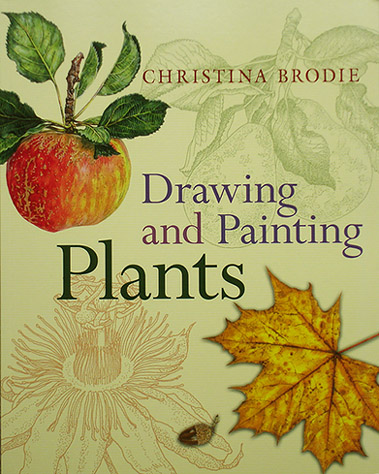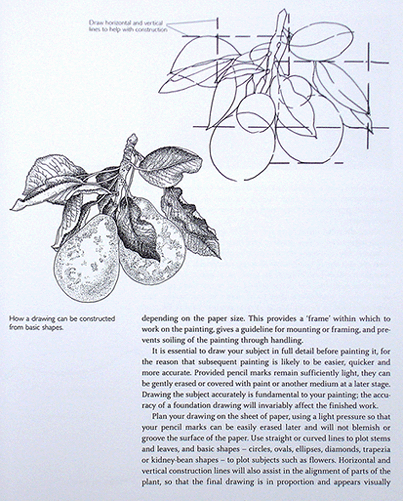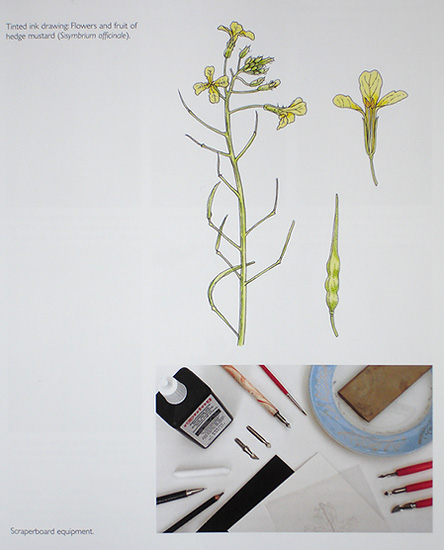
Published 2006 by A
& C Black
Publishers
Ltd, London.
A short review by Ian Walker.
UK.
Introduction.
Having enjoyed several
articles
contributed to Micscape over the years by Christina, I have been waiting
for this publication to arrive in the shops to buy my copy since I have
an inherent interest in drawing and painting and have many of the
materials discussed in the book at home. Although my own interest is
mainly in the geometrical & engineering drawing methods I greatly
admire the work of botanical artists past and present who have
contributed much to the understanding of the nature and structure of
plants and trees. Sadly this method of illustration is now disappearing
in favour of photographic methods. This is not supposed to be an in
depth review but a series of personal notes as I read the book giving a
glimpse of the artistry and accomplishment that Christina has managed
to attain in this publication.
First impressions.
Aesthetics are important and first
impressions are favourable, the soft back book is quite large at 11"
high by 8 3/4" wide [28x22cm] closed which gives plenty of space for
the
drawings and paintings to be shown at their best. The front cover is
colourful and well presented as shown in the title picture giving a
flavour of the
contents within,
whilst opening the book for the first time shows a well chosen typeface
and matte paper of nice weight and excellent finish. The spine is
both sewn and glued suggesting a good life and sits nicely spread on a
table or in the lap, but I am surprised the book was not released in
both hard and soft back for I certainly prefer the former and would
have
paid the extra premium for this option but overall I liked the format.
Contents.
The book consists of 144 pages including index and
supplementary information such as Bibliography and suppliers of
materials and is divided into 12 distinct Chapters. Paintings and text
from the book are copyrighted but with kind permission of the
publishers A & C Black
Publishers Ltd, London, I was given
permission to reproduce a couple of images of my choice and the cover
to
accompany the review but take into account these are representative but
not of the same quality as seen in the book. To see some similar
paintings you can visit Christina's
own article in Micscape 'An
Overview Of The Paintings by Christina Brodie' .
However the images
shown
on the website I think lack some fine detail and saturation in
comparison. The book starts with an introductory page on Christina's
background
leading us to Chapter 1.
Chapter 1.
The Plant Kingdom.
Not being an expert on plants and having been confused rather more
times than I care to mention on
classifications in previous publications, this short chapter of
five pages is one of the most concise and well structured explanations I
have seen with some well chosen drawings to give examples of plant,
fungi and algae with further explanations on
genus and species, the most useful terminology being in bold type.
Chapter 2.
Drawing and Watercolour Technique.
This chapter discusses drawing and
watercolour technique over 13 pages including pictures of paints,
brushes and paper required, these being
carefully laid out to show them at their best.
Christina goes into some detail on how to start your illustration
building up from accuracy in drawing using
construction lines through to final preparations with many hints and
tips along the way together with suggesting the most suitable materials
to
obtain a professional finish. A particular mention must be made of the
colour wheel known by many artists and photographers but here Christina
shows the actual names of paints such as Lemon Yellow, Prussian Blue
etc available from suppliers that can be used to obtain the colours
within the wheel. This is excellent and allows end users to buy specific
paints to build up their illustrations. This is a thoughtful and well
written chapter with plenty of step by step processes building up your
final painting.

From Chapter 2, Page 17. A drawing can be constructed from
basic
shapes.
Reproduced with kind permission of
the publishers A & C Black,
London.
Chapter 3.
Flowering Plants: Flowers, Fruits & Seeds.
Here the different parts
of flowers are discussed with line drawings accompanying the text to
put them in perspective. This leads onto dissection of flowers using
simple tools and the relevant safety precautions again with step by
step instructions on how to get good results. Further on in the chapter
many new terms are introduced all accompanied with good descriptions,
the chapter concludes with painting fruits and germinating seeds. Some
wonderful paintings can be found in this chapter my favourite being the
study
of seed growth painted in colour on a black background.
Chapter 4.
Flowering Plants: Leaves, Stems & Roots.
This follows on nicely from the
previous chapter and again introduces relevant terms associated with
the title together with numerous drawings of leaves from common trees
and plants culminating in paintings of variegated leaves
and roots.
Chapters 5 & 6.
More Painting Media and Monochrome Media.
Gouache and
acrylics are introduced in Chapter 5 along with typical results
expected from these
media whilst Chapter 6 discusses pen work in black ink, ink washes and
pencil; the chapter ending in the white and black scraperboard
technique. I particularly like Christina's scraperboard work and here
the
results are stunning, my favourites being a maple leaf and pears.

From Chapter 6, Page 77. Tinted ink drawing and
scraperboard equipment.
The lower picture of materials is typical of the care and attention to
detail.
Reproduced with kind
permission of the publishers A & C Black,
London.
Chapter 7.
Measuring and Magnifying Plant Parts.
Here we are in more familiar
territory in Micscape as the introduction to stereo microscopes and
compound microscopes are discussed together with measuring eyepieces
and stage micrometers and how they can be used in the context of
drawing and measuring plants and plant sections.
Chapter 8.
Trees.
A substantial chapter of 15 pages
goes into some detail on recording the shapes of trees, rendering these
in different media together with painting catkins, twigs and coniferous
foliage. Plenty of individual subjects can be seen throughout the
chapter helping the reader in the finer work making up these
paintings.
Chapters 9 & 10.
Fungi and Flowerless Plants.
Fungi discussed in Chapter 9 are one
of my favourite subjects in macro photography so it is nice to see how
Christina goes about drawing and painting these wonderful subjects. Again she introduces all the common terms and distinguishing features
leading onto finding fungi and typical habitats. This leads us onto
Chapter 10 which include well known subjects such as
ferns, horsetails, algae and lichens. Here we have some of the most
delicately painted subjects in the book with great attention to colour
and detail.
Chapters 11 & 12.
Presenting Your Work and Further Study.
Chapter 11 gives the reader sound
advice on organizing and presenting your work both for yourself and
exhibitions whilst Chapter 12 supplies information on organizations and
field studies together with photographs of typical habitats together
with common sense and discretion in obtaining samples in the field.
Conclusion.
You neither have to be an expert in
painting technique nor understand the finer detail of plant anatomy to
enjoy this book, indeed, I see its purpose in trying to persuade those
of
us who have never tried painting these subjects to have a go following
Christina's step by step processes. The book is lavishly illustrated
with many of her paintings and it is a joy just to study the detail of
the work she has accomplished. Her background in teaching
botanical painting for the RHS at Rosemoor shines through as it is
thoroughly readable
throughout in a concise and illuminating manner.
Highly Recommended.
Book Details:
Drawing and Painting Plants by Christina
Brodie.
First published in Great
Britain in 2006
A & C Black Publishers Ltd
38 Soho square
London W1D 3HB
www.acblack.com
Synopsis
on
publisher's
website.
RRP
£19.
Price
£13.19
from
Amazon
(UK).
Christina Brodie's website is at www.queen-christina.com where contact details can also be found.
Acknowledgement:
Thank
you
to
Ms
Claire
Weatherhead,
Permissions
Dept at
the
publisher's
A.
C.
Black
for
permission
to
reproduce
the
book
cover
and
selected
pages.